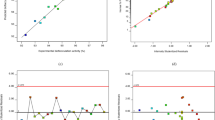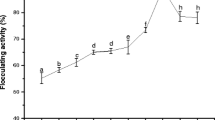Abstract
Bioflocculants produced by six bacteria obtained from activated sludge at a wastewater treatment plant were quantified, purified, and characterized. Effects of pH, temperature, cationic salt content, and specific potential inhibitors on the flocculating activities of the bioflocculants were also determined. Bioflocculants produced by the different bacterial isolates ranged between 6.33 and 27.66 g/L in concentration and were composed of both carbohydrate and protein in varying amounts, as well as a relatively high concentration of uronic acid. The flocculating activity of the broth culture increased during the logarithmic phase of bacterial growth with a maximum ranging from 2.395 to 3.709/OD. Optimum pH for the flocculating activity of the bioflocculants was between 8 and 9, with generally higher flocculating activity observed at 28°C. Of the cations tested, Mg2+ and Mn2+ improved flocculating activity up to 5.2 fold. The stability of these bacterial bioflocculants under various environmental and nutritional conditions suggests their possible use in the industries and environmental applications. Therefore, this study details important implications in providing a safer alternative flocculation method for wastewater treatment.
Similar content being viewed by others
References
Shih, I. L., L. C. Van, H. G. Lin, and Y. N. Chang (2001) Production of a biopolymer flocculant from Bacillus licheniformis and its flocculation properties. Bioresour. Technol. 78: 267–272.
Zheng, Y., Z. Ye, X. Fang, Y. Li, and W. Cai (2008) Production and characterization of a bioflocculant produced by Bacillus sp. F19. Bioresour. Technol. 99: 7686–7691.
Salehizadeh, H. and S. A. Shojaosadati (2001) Extracellular biopolymeric flocculants: Recent trends and biotechnological importance. Biotechnol. Adv. 19: 371–385.
Salehizadeh, H., M. Vossoughi, and I. Alemzadeh (2000) Some investigations on bioflocculant producing bacteria. Biochem. Eng. 5: 39–44.
Dearfield, K. L. and C. O. Ambermathy (1988) Acrylamide: Its metabolism, developmental and reproductive effects, genotoxicity and carcinogenicity. Mutat. Res. 195: 45–77.
Vanhorick, M. and W. Moens (1983) Carcinogen-mediated induction of SV40 DNA amplification is enhanced by acrylamide in Chinese hamster CO60 cells. Carcinogenesis 4: 1459–1463.
Kowall, N. W., W. W. Pendlebum, J. B. Kessler, D. P. Perl, and M. F. Beal (1989) Aluminium-induced neurofibrillary degeneration affects a subset of neurons in rabbit cerebral cortex, basal forebrain and upper brainstem. Neurosci. 29: 329–337.
Master, C. L., G. Multhaup, G. Simms, J. Pottgiesser, R. N. Martins, and K. Beyreuther (1985) Neuronal origin of a cerebral amyloid: Neurofibrillary tangles of Alzheimer’s disease contain the same protein as the amyloid of plaque cores and blood vessels. EMBO J. 4: 2757–2763.
Deng, S. B., R. B. Bai, X. M. Hu, and Q. Luo (2003) Characteristics of a bioflocculant produced by Bacillus mucilaginosus and its use in starch and wastewater treatment. Appl. Microbiol. Biotechnol. 60: 588–593.
Kumar, C. G, H. Joo, J. Choi, Y. Koo, and C. Chang (2004) Purification and characterization of an extracellular Bacillus sp. I-450. Enz. Microb. Technol. 34: 673–450.
Dugan, R. (1984) Flocculation in Biotechnology and Separation System. pp. 337–351. In: Y. A. Attia (ed.). Elsevier Science, Amsterdam.
Dermlim, W., P. Prasertsan, and H. Doelle (1999) Screening and characterization of bioflocculant produced by isolated Klebsiella sp. Appl. Microbiol. Biotechnol. 52: 698–703.
Nakata, K. and R. Kurane (1999) Production of extracellular polysaccharide bioflocculants by Klebsiella pneumoniae. Biosci. Biotechnol. Biochem. 63: 2064–2068.
Wang, S., W. Gong, X. Lu, L. Tian, Q. Yue, and B. Gau (2007) Production of a novel bioflocculant by culture of Klebsiella mobilis using dairy wastewater. Biochem. Engin. J. 36: 81–86.
Kurane, R., K. Hatamochi, T. Kakuno, M. Kiyohara, T. Tajima, M. Hirano, and Y. Taniguchi (1995) Chemical structure of lipid bioflocculant produced by Rhodococcus erythropolis. Agric. Biol. Chem. 59: 1652–1656.
Takeda, M., R. Kurane, J. Koizumi, and I. Nakamura (1991) A protein bioflocculant produced by Rhodococcus erythropolis. Agric. Biol. Chem. 55: 2663–2664.
Kurane, R. and H. Matsuyama (1994) Production of bioflocculant by mixed culture. Biosci. Biotechnol. Biochem. 58: 1589–1594.
Tong, Z., L. Zhe, and Z. Huai-lan (1999) Microbial flocculant and its application in environmental protection. J. Env. Sci. 11: 1–12.
Toeda, K. and R. Kurane (1991) Microbial flocculant from Alcaligenes cupidus KT201. Agric. Biol. Chem. 55: 2793–2799.
Salehizadeh, H. And S. A. Shojaosadati (2002) Isolation and characterization of the bioflocculant produced by Bacillus firmus. Biotechnol. Lett. 24: 35–40.
Suh, H., G. Kwon, C. Lee, H. Kim, H. Oh, and B. Yoon (1997) Characterization of bioflocculant produced by Bacillus sp. DP-152. J. Ferm. Bioeng. 84: 108–112.
Brosius, J., J. L. Palmer, H. P. Kennedy, and H. F. Nuller (1978) Complete nucleotide sequence of a 16S ribosomal RNA gene from Escherichia coli. Proc. Natl. Acad. Sci. 75: 4801–4805.
Marchesi, J. R., T. Sato, A. J. Weightman, T. A. Martin, J. C. Fry, S. J. Hiom, D. Dymock, and W. G. Wade (1998) Design and evaluation of useful bacterium-specific PCR primers that amplify genes coding for 16S rRNA. Appl. Env. Microbiol. 64: 795–799.
Kurane, R., K. Hatamochi, T. Kakuno, M. Kiyohara, K. Kawaguchi, Y. Mizuno, M. Hirano, and Y. Taniguchi (1994) Production of a bioflocculant by Rhodococcus erythropolis S-l grown on alcohols. Biosci. Biotechnol. Biochem. 58: 428–429.
Chaplin, M. F. (1994) Monosaccharides carbohydrate analysis: A practical approach. pp. 2–6. In M. F. Chaplin and J. F. Kennedy (eds.). Oxford University Press, NY. USA.
Plummer, D. T. (1978) An introduction to practical biochemistry. 2nd ed., pp. 158–159. McGraw-Hill Press, London.
Kurane, R., K. Toeda, K. Takeda, and T. Suzuki (1986) Culture conditions for production of microbial flocculant by Rhodococcus erythropolis. Agric. Biol. Chem. 50: 2309–2313.
McKinney, R. E. (1956) Biological flocculation. Biological treatment of sewage and industrial wastes. 1: 88–117.
Shimofuruya, H., A. Koide, K. Shirota, T. Tsuji, M. Nakamura, and J. Suzuki (1996) The production of flocculating substance(s) by Streptomyces griseus. Biosci. Biotechnol. Biochem. 60: 498–500.
Nakamura, J., S. Miyashiro, and Y. Hirose (1976b) Conditions of production of microbial cell flocculant by Aspergillus sojae AJ-7002. Agric. Biol. Chem. 40: 1341–1347.
Kim, Y. (1993) The production and properties of exo-polysaccharides (POL-IIs) by Bacillus sp. LK-1. Kor. J. Appl. Microbiol. Bioeng. 21: 478–485.
Yokoi, H., O. Natsuda, J. Hirose, S. Hayashi, and Y. Takasaki (1995) Characteristics of biopolymer flocculant produced by Bacillus sp. PY-90. J. Ferment. Bioeng. 79: 378–380.
Yokoi, H., T. Arima, S. Hayashi, and Y. Takasaki (1996) Flocculation properties of poly (γ-glutamic acid) produced by Bacillus subtilis. J. Ferment. Bioeng. 82: 84–87.
Takeda, M., J. Koizumi, H. Matsuoka, and M. Hikuma (1992) Factors affecting the activity of a protein bioflocculant produced by Nocardia amarae. J. Ferment. Bioeng. 74: 408–409.
Kurane, R. and Y. Nohata (1991) Microbial flocculation of waste liquids and oil emulsion by a bioflocculant from Alcaligenes latus. Agric. Biol. Chem. 55: 1127–1129.
Napoli, C., F. Dazzo, and D. Hubbell (1975) Production of cellulose microfibrils by Rhizobium. Appl. Microbiol. 30: 123–131.
Sakka, K. and H. Takahashi (1981) DNA as a flocculation factor in Pseudomonas sp. Agric. Biol. Chem. 45: 2869–2876.
Nakamura, J., S. Miyashiro, and Y. Hirose (1976) Screening, isolation and some properties of microbial cell flocculants. Agric. Biol. Chem. 40: 377–383.
Sletmoen, M., G. Maurstad, P. Sikorski, B. S. Paulsen, and B. T. Stokke (2003) Characterization of bacterial polysaccharides: Steps towards single-molecular studies. Carbohydr. Res. 338: 2459–2475.
Shubo, D., G. Yu, and T. Yen Peng (2005) Production of a bioflocculant by Aspergillus parasiticus and its application in dye removal. Colloids Surf. B 44: 179–186.
Higgins, M. J. (1995) The roles and interactions of metal salts, proteins, and polysaccharides in the settling and dewatering of activated sludge. Ph.D. Thesis. Virginia Polytechnic Institute and State University, Blacksburg, Virginia.
Cheng, X. and L. A. Kaplan (2003) Simultaneous analyses of neutral carbohydrates and amino sugars in freshwaters with HPLC-PAD. J. Chromatogr. Sci. 41: 1–5.
Lian, B., Y. Chen, J. Zhao, H. H. Teng, L. Zhu, and S. Yuan (2008) Microbial flocculation by Bacillus mucilaginosus: Applications and mechanisms. Bioresour. Technol. 99: 4825–4831.
Fujita, M., M. Ike, S. Tachibana, G. Kitada, S. M. Kim, and Z. Inoue (2000) Characterization of a bioflocculant produced by Citrobacter sp. TKF04 from acetic and propionic acids. J. Biosci. Bioeng. 89: 40–46.
Kurane, R., K. Hatamochi, T. Kakuno, M. Kiyohara, K. Kawaguchi, Y. Mizuno, M. Hirano, and Y. Taniguchi (1994) Purification and characterization of lipid bioflocculant produced Rhodococcus erythropolis. Biosci. Biotechnol. Biochem. 58: 1977–1982.
Mishra, A., M. Yadav, B. Agarwal, and S. Rajani (2004) Use of polyacrylamide-grafted Plantago psyllium mucilage as a flocculant for treatment of textile wastewater. Colloid Polym. Sci. 282: 722–727.
Faust, S. D. and O. M. Aly (1998) Chemistry of water treatment. 2nd ed., p. 581. CRC Press LLC, Lewis Publishers, NY, USA.
Zouboulis, A. I., X. Chaib, and I. A. Katsoyiannis (2004) The application of bioflocculant for the removal of humic acids from stabilized landfill leachates. J. Env. Manag. 70: 35–41.
Author information
Authors and Affiliations
Corresponding author
Rights and permissions
About this article
Cite this article
Buthelezi, S.P., Olaniran, A.O. & Pillay, B. Production and characterization of bioflocculants from bacteria isolated from wastewater treatment plant in South Africa. Biotechnol Bioproc E 15, 874–881 (2010). https://doi.org/10.1007/s12257-009-3002-7
Received:
Revised:
Accepted:
Published:
Issue Date:
DOI: https://doi.org/10.1007/s12257-009-3002-7




